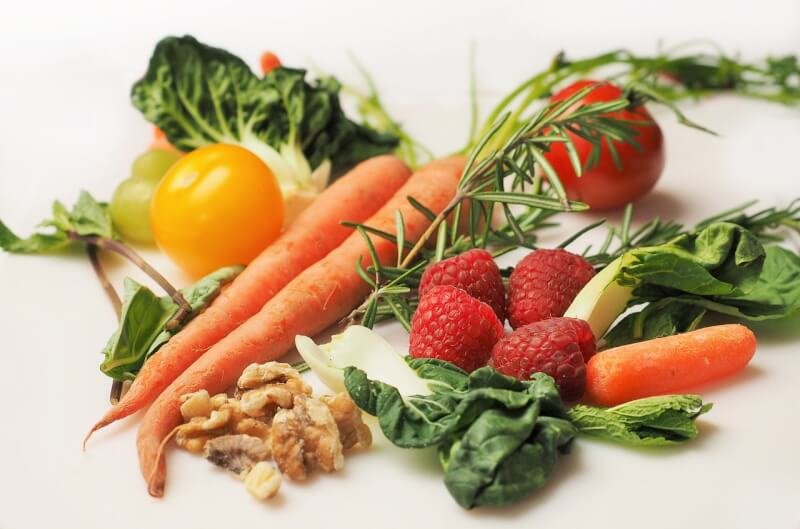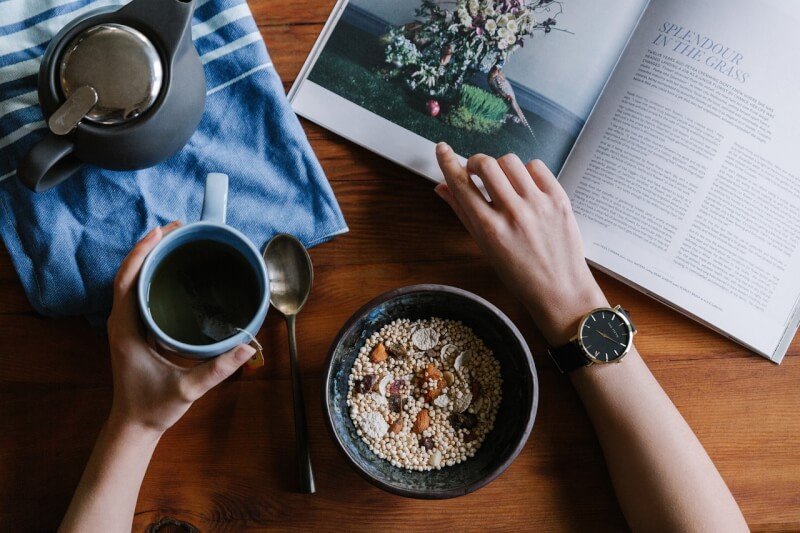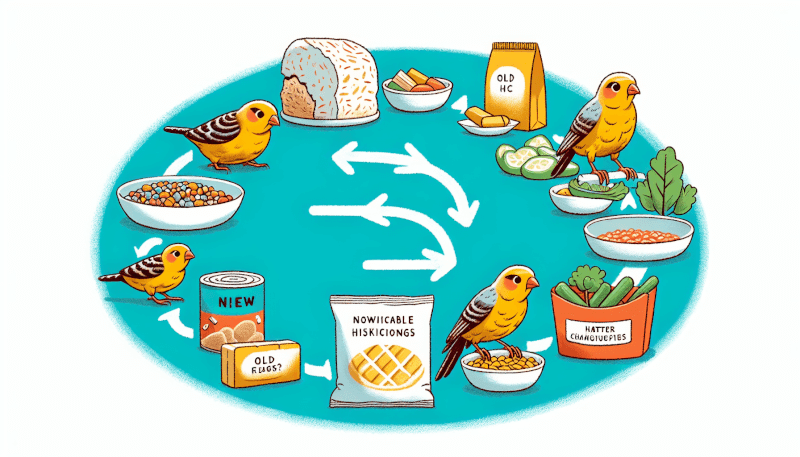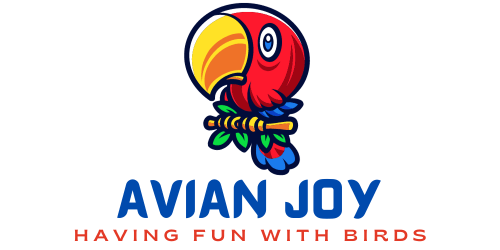So you’ve decided to transition your bird to a new diet, but you’re not sure where to begin. Don’t worry, we’ve got you covered! In this article, we will guide you through the process of introducing your bird to a new diet, ensuring a smooth and successful transition. From understanding the importance of a gradual shift to choosing the right food options, we’ll provide you with all the necessary tips and tricks to help your feathered friend embrace a healthier, more balanced diet. Get ready to embark on a culinary adventure with your bird, one step at a time!

Assessing Your Bird’s Current Diet
Observing your bird’s eating habits
When transitioning your bird to a new diet, it is crucial to first assess their current eating habits. Observe what types of food your bird prefers, how much they eat, and their overall appetite. Take note of any patterns or behaviors that may indicate a strong attachment to certain foods or a reluctance to try new ones. This will help you understand your bird’s likes and dislikes, which can inform your transition plan.
Evaluating the nutritional content of the current diet
The next step in assessing your bird’s current diet is to evaluate its nutritional content. Research the specific dietary needs of your bird’s species to determine if their existing diet provides them with a well-balanced and healthy range of nutrients. Take into account the types of food they are consuming, their proportions, and the key nutrients they require for optimal health. This evaluation will help you identify any potential gaps or deficiencies in their current diet.
Identifying any potential health concerns
While evaluating your bird’s current diet, it is essential to be mindful of any potential health concerns. Look for signs of malnutrition or vitamin deficiencies, such as weight loss, dull feathers, or changes in behavior. If you notice any worrisome symptoms, consult with a veterinarian to address these concerns promptly. Identifying and addressing any existing health issues is an important step before proceeding with a diet transition for your bird’s overall well-being.
Choosing a New Diet
Researching different bird diets
Before transitioning your bird to a new diet, it is crucial to conduct thorough research on the different bird diets available. Consider the specific needs of your bird’s species as diet requirements vary greatly among different types of birds. Look into different options such as seed-based diets, pellet-based diets, or fresh food diets, and compare their nutritional values and benefits. Gathering this knowledge will help you make an informed decision when selecting the best diet for your feathered friend.
Consulting a veterinarian
To ensure the suitability and safety of a new diet for your bird, it is highly recommended to consult with a veterinarian. A veterinarian specializing in avian care can provide valuable insights and guidance based on their expertise. They can help you choose the most appropriate diet for your bird, taking into consideration any health conditions, dietary restrictions, or individual preferences. A veterinarian’s professional opinion will greatly contribute to a successful diet transition process.
Considering your bird’s specific needs and preferences
When choosing a new diet for your bird, it is essential to consider their specific needs and preferences. Some birds may have allergies or sensitivities to certain ingredients, while others may have picky eating habits. Take into account your bird’s likes and dislikes, as well as any dietary restrictions or health conditions they may have. By tailoring the diet to their individual needs, you can ensure a smoother transition and optimize their overall nutritional intake.
Gradual Transition
Understanding the importance of a gradual transition
A gradual transition is vital when introducing a new diet to your bird. Birds can be resistant to sudden changes in their food, and a sudden switch can lead to digestive upset or refusal to eat. By gradually introducing the new diet, you allow your bird’s digestive system to adapt and minimize the chances of any negative reactions. This patient approach also gives your bird time to adjust to the new tastes and textures, increasing the likelihood of a successful transition.
Creating a transition plan
To implement a gradual transition, create a well-thought-out transition plan. Start by mixing a small portion of the new diet with their current food, gradually increasing the proportion of the new food over several days or weeks. Monitor your bird’s response throughout the process and adjust the transition speed accordingly. A transition plan helps ensure a balanced approach to introducing the new diet while minimizing any potential discomfort or reluctance from your bird.
Monitoring your bird’s response to the new diet
Throughout the transition process, it is important to closely monitor your bird’s response to the new diet. Observe their appetite, digestion, and overall well-being. Look for any signs of refusal to eat, digestive issues such as diarrhea or constipation, or changes in behavior. If you notice any concerning symptoms, slow down the transition or consult with a veterinarian for guidance. Being attentive to your bird’s response allows you to make any necessary adjustments and ensure a successful dietary transition.
Introducing New Foods
Selecting a variety of nutritious foods
When introducing new foods to your bird, it is important to offer a variety of nutritious options. Include fresh fruits and vegetables, sprouted seeds, and high-quality pellets in their diet. Aim for a colorful assortment of fruits and vegetables to provide a range of vitamins and minerals. Offering a variety of foods not only enhances the nutritional value of their diet but also adds enrichment and stimulation to their feeding experience.
Introducing new foods gradually
Similar to the gradual transition approach, new foods should also be introduced gradually. Start by offering small portions of the new food alongside their current diet. Gradually increase the amount of the new food over time, encouraging your bird to explore and try different flavors. Patience is key during this process, as it may take some time for your bird to accept and enjoy the new foods. Stay consistent and persistent, and remember that each bird has its own pace when it comes to trying new foods.
Making the new foods appealing to your bird
To make the new foods more appealing to your bird, consider presenting them in different ways. Some birds may prefer fresh fruits and vegetables chopped into smaller pieces, while others may enjoy whole pieces or sprouted seeds. Experiment with different food presentations, textures, and combinations to find what works best for your bird. Additionally, offering the new foods during interactive playtime or using them as treats/rewards can make the experience more enjoyable and enticing for your feathered companion.

Balancing Nutritional Needs
Understanding the essential nutrients for birds
To ensure your bird’s well-being, it is crucial to understand the essential nutrients they need in their diet. These may include proteins, carbohydrates, healthy fats, vitamins, and minerals. Research the specific nutritional requirements of your bird’s species and choose a diet that provides an appropriate balance of these essential nutrients. Be mindful of any nutrient deficiencies or excesses to maintain optimal health and prevent any potential health issues.
Establishing a balanced diet
To achieve a balanced diet, incorporate a variety of foods that meet your bird’s nutritional needs. A balanced diet for most birds typically consists of high-quality pellets or formulated diets, supplemented with fresh fruits, vegetables, and occasional protein sources such as nuts or lean meats. Offer a diverse range of foods to ensure a broad spectrum of nutrients are being provided. Remember to monitor the proportions and adjust as needed to maintain a well-balanced and enjoyable diet for your bird.
Considering supplements if necessary
In some cases, supplements may be necessary to meet your bird’s specific nutritional needs. However, it is essential to consult with a veterinarian before introducing any supplements to your bird’s diet. A veterinarian can guide you on the appropriate types and dosages of supplements based on your bird’s individual circumstances. Avoid self-administering supplements without professional advice, as improper supplementation can lead to imbalances or toxicity.
Mealtime Strategies
Establishing a consistent feeding schedule
Establishing a consistent feeding schedule is important for your bird’s overall well-being. Birds thrive on routine, so try to feed them at the same times each day. Consistency helps regulate their metabolism, digestion, and energy levels. Set a schedule that aligns with your bird’s natural rhythm and observe their appetite and behavior to ensure they are receiving adequate nutrition.
Offering meals in a stress-free environment
Creating a stress-free environment during mealtimes is essential for your bird to fully enjoy their food. Find a quiet and calm area where your bird feels safe and comfortable. Minimize distractions, such as loud noises or sudden movements, that can disrupt their mealtime. Additionally, ensure that their feeding area is clean, free from contaminants, and easily accessible. A stress-free environment promotes healthy eating habits and a positive feeding experience for your bird.
Avoiding common feeding mistakes
There are common feeding mistakes to avoid when transitioning your bird to a new diet. One mistake is abruptly removing their old diet without a gradual transition, which can lead to digestive issues and refusal to eat. Another mistake is overfeeding or underfeeding, which can result in weight gain or malnutrition, respectively. Additionally, be cautious of offering unhealthy or inappropriate foods as treats, as they can negatively impact your bird’s overall health. Being mindful of these mistakes will help ensure a smooth and successful transition for your feathered friend.

Transitioning Challenges
Dealing with resistance to change
Resistance to change is a common challenge when transitioning your bird to a new diet. Birds can be creatures of habit and may exhibit reluctance to accept new foods initially. To address this challenge, be patient and persistent. Offer the new food alongside their old diet, gradually increasing the proportion of the new food. Be a positive role model by eating the new food in front of your bird, demonstrating its desirability. Providing praise and encouragement when your bird shows interest or takes a bite can also motivate them to embrace the new diet.
Addressing potential digestive issues
During the transition process, your bird may experience digestive issues such as diarrhea or constipation. These issues can occur due to the sudden change in diet or the introduction of new ingredients. If you notice any digestive problems, slow down the transition and ensure your bird has access to fresh water at all times. If the issues persist or worsen, consult with a veterinarian for further guidance and potential medical interventions. Addressing any digestive issues promptly will help ensure your bird’s comfort and overall health.
Seeking professional advice if needed
If you encounter significant challenges or concerns during the diet transition process, do not hesitate to seek professional advice. A veterinarian specializing in avian care can provide guidance tailored to your bird’s specific needs. They have the expertise to address any health issues, offer custom diet recommendations, and suggest strategies to facilitate the transition. By seeking professional advice, you can navigate any obstacles and ensure the successful transition of your bird to a new diet.
Monitoring Your Bird’s Health
Keeping track of your bird’s weight
Regularly monitoring your bird’s weight is an essential part of maintaining their overall health. Fluctuations in weight can indicate potential health issues or imbalances in their diet. Use a reliable and accurate scale to weigh your bird regularly, keeping a record to track any significant changes. Sudden weight loss or gain may require adjustments to their diet or prompt a visit to the veterinarian. Regular weight monitoring provides valuable information and allows for timely interventions if necessary.
Observing changes in behavior or appearance
In addition to tracking their weight, it is important to observe your bird for any changes in behavior or appearance. Changes in appetite, energy levels, feather quality, or overall demeanor can be indicators of potential health concerns. Pay attention to any abnormal behaviors or signs of discomfort and consult with a veterinarian if you notice anything unusual. Prompt attention and proactive care are essential in maintaining your bird’s well-being.
Regular check-ups with the veterinarian
Regular check-ups with a veterinarian are crucial for your bird’s ongoing health and well-being. Schedule regular visits, even when your bird appears healthy, to ensure they receive comprehensive care and preventive measures. During these appointments, discuss your bird’s diet, any concerns or observations you have noticed, and seek guidance on maintaining their optimal health. Regular veterinary care provides professional insights, early disease detection, and reassurance that your bird is thriving in their new diet.

Introducing New Treats
Finding appropriate treats for your bird
Introducing treats into your bird’s diet can be a delightful addition to their meals and an opportunity to introduce new flavors and textures. However, it is important to find appropriate treats that are safe and healthy for your bird. Avoid offering sugary or processed treats, as they can contribute to obesity and other health issues. Instead, focus on treats that are specifically formulated for birds, such as small pieces of fresh fruits or vegetables, whole grains, or specially made bird treats available in pet stores. Ensuring that treats are nutritionally beneficial will maintain your bird’s overall diet balance.
Gradually incorporating treats into the diet
When introducing treats, it is important to do so gradually, similar to introducing new foods. Start by offering small portions of the treats alongside their regular diet. Over time, you can increase the frequency and quantity of treats, ensuring they remain a small portion of your bird’s overall diet. Treats should be given sparingly to prevent overindulgence or imbalances in their nutrition intake. Gradually incorporating treats into the diet allows your bird to enjoy them in moderation while maintaining a healthy and balanced eating regimen.
Avoiding unhealthy treat options
While treats can be a source of joy and excitement for your bird, it is crucial to avoid offering unhealthy options. Many human foods, such as chocolate, avocado, or caffeine, are toxic to birds and should never be offered as treats. Additionally, refrain from giving your bird high-sugar or fattening treats, as they can contribute to obesity and other health problems. Always check the safety of treats before offering them to your bird and consult with a veterinarian if you have any doubts or concerns.
Transitioning Multiple Birds
Managing multiple birds with different dietary needs
Transitioning multiple birds to a new diet can present unique challenges, especially when they have different dietary needs. Take into consideration the specific requirements of each bird’s species and their individual health conditions. While it may be challenging to cater to each bird’s needs, it is crucial to ensure that all birds receive a nutritionally balanced diet. Consult with a veterinarian to create a customized plan that takes into account the specific needs of each bird while maintaining a harmonious feeding routine.
Separating birds during mealtime if necessary
If your birds have significantly different dietary needs or personalities, it may be necessary to separate them during mealtime. This ensures that each bird receives the appropriate diet without competition or potential health risks. Separating birds can also prevent the ingestion of potentially harmful foods, the development of unhealthy eating habits, or excessive food waste. Be mindful of the individual dynamics within your flock and make adjustments as needed to accommodate each bird’s unique needs.
Ensuring all birds are transitioning successfully
While managing multiple birds during a diet transition, it is important to ensure that all birds are transitioning successfully. Monitor each bird’s responses and progress individually. Some birds may embrace the new diet quickly, while others may require more time or encouragement. Observe their behaviors, appetite, and overall health to gauge how well they are adapting. If you notice any bird struggling or falling behind in the transition, provide additional support, and consult with a veterinarian for guidance. By ensuring the successful transition of all birds, you create a balanced and harmonious feeding routine for your flock.
Transitioning your bird to a new diet is a process that requires careful consideration, patience, and attention to detail. By assessing your bird’s current diet, choosing an appropriate new diet, implementing a gradual transition, introducing new foods thoughtfully, and balancing their nutritional needs, you can ensure a smooth and successful transition. Remember to monitor your bird’s health, seek professional advice when needed, and incorporate treats wisely to maintain a well-rounded and nutritious diet for your feathered companion. With time and dedication, you can provide your bird with the best possible diet for a happy, healthy, and vibrant life.



